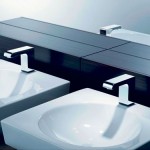Have you ever stopped to consider how much thought and effort went into the design of the spaces you visit every day? You may not realize it, but your favorite restaurants, neighborhood grocery store and go-to movie theater follow some very specific design principles in order to create a unique space that is both visually appealing and user-friendly.
Much like home designers, commercial architects and interior designers think of spaces in their totality. To a commercial designer, every area — from the entryway to the public bathrooms to the behind-the-scenes storage areas — must be considered when working on a new project. One way commercial designers help create a unique look and feel throughout public spaces is through the use of repetition. Repeating a pattern, color or texture in more than one area of a space lends a feeling of continuity.
According to Judd Lord, director of industrial design at Delta Faucet Company, this attention to detail makes commercial environments a great place to look for design inspiration.
“Highly-designed commercial spaces allow people to get a sense of what their own home may feel like in terms of color palette, textures, combination of materials and accents prior to actually committing to a design,” Lord said. “For example, visiting high-end hotels can provide a great way to ‘live’ in a particular design aesthetic to see if it suits you.”
The next time you stay at a hotel, look for hints of repetition. You may find that the orange sofas in the lobby, for instance, carry through to your guest room pillows or decorative accents. Or, perhaps the wrought iron door handles match the window hardware perfectly. The small touches that regularly go unnoticed help to create a distinct sense of place in commercial spaces.
When deciding what design elements to incorporate into a commercial building, designers consider not only how certain aspects can enhance overall design aesthetic, but also how they can be used to promote functionality in the space. The role this plays in commercial buildings is perhaps demonstrated most readily when taking the public bathroom into consideration. For instance, a single-room bathroom with a plush sitting area and vanity mirror may enhance the shopping experience for customers at a high-end boutique, while busy shoppers at large malls may prefer multiple stalls to help avoid long bathroom lines. For both of these spaces, innovative products can help enhance the bathroom experience through increased functionality.
With Delta faucets that feature Proximity Sensing Technology, the entire faucet acts as a sensor, activating the flow of water instantly and effortlessly when it detects the presence of your hands. Faucets that employ this type of technology are more dependable than traditional infrared sensors, which can be unreliable in low-light or when wearing dark clothing.
The next time you are out shopping at the grocery store, try to appreciate small design details, such as the layout of shopping aisles that makes it easier for you to navigate the store and return home more quickly. Attention to these details not only helps a business operate efficiently, but also creates a better experience for consumers.
This article is courtesy of Brandpoint.
